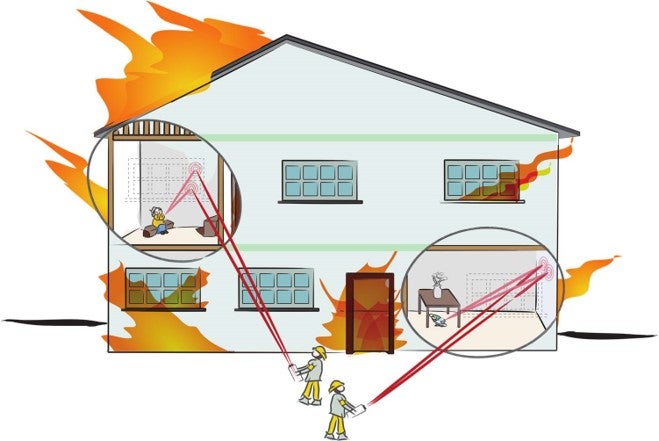Things it would be great to be able to see through: cargo trucks at ports. Burning homes. Buildings in hostile cities. Coatings on pills. Fog on dusty highways.
Forget X-ray vision; try terahertz wave specs.
An Arizona State University engineer recently received a prestigious grant to create a way to see hidden objects through walls and to look around corners.
George Trichopoulos envisions a system of a special camera paired with goggles that employ millimeter waves used in airport security as well as higher frequencies (terahertz waves).
“It can see through our clothes,” said Trichopoulos, an assistant professor in the School of Electrical, Computer and Energy Engineering in the Ira A. Fulton Schools of Engineering. “Anything you want to see that’s not a direct line of sight, or where you cannot approach closely.”
Terahertz waves are electromagnetic, like the radio waves you listen to, microwaves you cook with, infrared in your remote controls, visible light that you can see, ultraviolet that you get a sunburn from and X-rays that see what’s wrong with you. Terahertz waves fall in the middle of all those, and they're the least-exploited on the spectrum.
In the past 15 years, research into terahertz waves has heated up for applications for communication, sensing, imaging and spectroscopy.
“For imaging this is attractive because these waves can penetrate materials that are not good conductors,” Trichopoulos said. “It can penetrate clothing, wood, plastic, drywall. Cinder block is not so easy because it absorbs (the waves). It cannot penetrate water. Water kills magnetic waves. Because it can penetrate many materials, it allows us to see through packages and clothing, like you see at the airport. It has these interesting properties that has motivated many researchers to make imaging systems that use these waves to see.”
Instead of using the penetrating capabilities of the waves, Trichopoulos’ application will delve into how the waves reflect from surrounding environments.
If you stare at a wall, it does not reflect what’s behind you. But in the terahertz spectrum, many surfaces act like mirrors.
“If a surface is well-polished, like a mirror, we can use it to see in other directions indirectly,” Trichopoulos said. “The interesting thing with these frequencies, most surfaces reflect the signal in only one direction. Everything in these frequencies is behaving as a mirror: the door, the walls, the ceiling, sometimes the floor if it’s not something that’s extremely rough. All these surfaces can operate as a mirror. We can use these surfaces to look around obstacles. We can see inside a room, even if we’re not standing in front of the door. We can use the door as a mirror to see inside.”
It’s easy to picture firefighters using a terahertz wave device to search a building without going inside. But what if they can’t see the whole picture from their angle? Active imaging will take care of that.

Looking around obstacles will enable rescue or surveillance in areas and buildings where access is limited. Illustration by Tiago Allen
Let’s say your camera has a flashlight, which illuminates the whole scene. It sends out pulses that are signals. Those pulses scatter around in multiple ways and come back to the camera. The camera takes them and creates a 3D image. You get not only the geometry of the shape, but where it is and how far away it is, similar to LIDAR — Light Detection and Ranging, a remote sensing method that uses light in the form of a pulsed laser to measure ranges.
Algorithms will control post-processing of the data so users understand where line-of-sight objects and non-line-of-sight objects are. Post-processing will stitch together multiple views to give a clear and complete view.
“It doesn’t make the building transparent, but you get the information of what’s behind the wall,” Trichopoulos said.
He imagines melding the technology with augmented reality. (Along the lines of the AR used in the Pokémon Go craze a couple years back, when people wandered around looking at video game characters through their smartphones.)
“We take the images from the terahertz camera and fuse them inside the (augmented reality) goggles, so when a firefighter is looking through the window he can select the surfaces he wants to turn into mirrors,” he said. “Then, through the goggles, he can project the information onto the real world. He can turn the building into a frame by projecting information into the real world he gets from the terahertz camera.”
Possible applications include nondestructive inspection, quality control for pharmaceutical companies, museums studying paintings, military and search and rescue. “It’s a big area,” Trichopoulos said.
The five-year award is for $500,000, granted by the National Science Foundation. It is an NSF Career Award, the foundation’s most prestigious award in support of early-career faculty who have potential to serve as academic role models in research and education and to lead advances in the mission of their department or organization.
Top image: iStock photo
More Science and technology

ASU researchers engineer product that minimizes pavement damage in extreme weather
Arizona State University researchers have developed a product that prevents asphalt from softening in extreme heat and becoming brittle in freezing cold. The product reduces pavement cracks,…

New study finds the American dream is dying in big cities
Cities have long been celebrated as places of economic growth and social mobility, but new research suggests that their role in fostering opportunity has changed dramatically…

Ancient sea creatures offer fresh insights into cancer
Sponges are among the oldest animals on Earth, dating back at least 600 million years. Comprising thousands of species, some with lifespans of up to 10,000 years, they are a biological enigma.…
